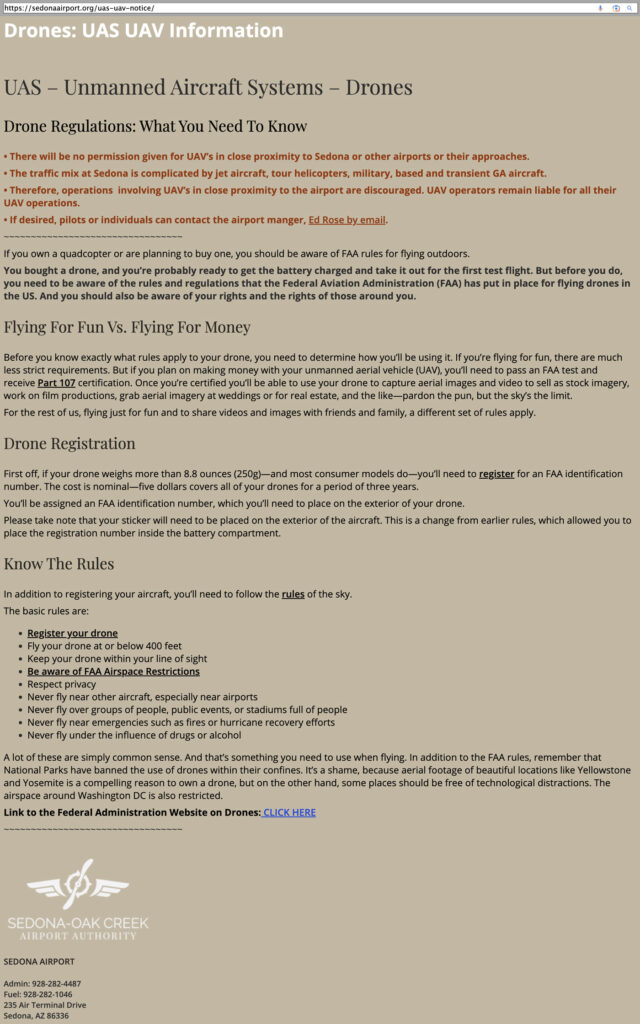This page is an unedited copy of: https://sedonaairport.org/uas-uav-notice/
The airport removed this page and content as it correctly states that you can fly a drone at or below 400 feet for private purposes.
UAS – Unmanned Aircraft Systems – Drones
Drone Regulations: What You Need To Know
• There will be no permission given for UAV’s in close proximity to Sedona or other airports or their approaches.
• The traffic mix at Sedona is complicated by jet aircraft, tour helicopters, military, based and transient GA aircraft.
• Therefore, operations involving UAV’s in close proximity to the airport are discouraged. UAV operators remain liable for all their UAV operations.
• If desired, pilots or individuals can contact the airport manger, Ed Rose by email.
~~~~~~~~~~~~~~~~~~~~~~~~~~~~~~~~~
If you own a quadcopter or are planning to buy one, you should be aware of FAA rules for flying outdoors.
You bought a drone, and you’re probably ready to get the battery charged and take it out for the first test flight. But before you do, you need to be aware of the rules and regulations that the Federal Aviation Administration (FAA) has put in place for flying drones in the US. And you should also be aware of your rights and the rights of those around you.
Flying For Fun Vs. Flying For Money
Before you know exactly what rules apply to your drone, you need to determine how you’ll be using it. If you’re flying for fun, there are much less strict requirements. But if you plan on making money with your unmanned aerial vehicle (UAV), you’ll need to pass an FAA test and receive Part 107 certification. Once you’re certified you’ll be able to use your drone to capture aerial images and video to sell as stock imagery, work on film productions, grab aerial imagery at weddings or for real estate, and the like—pardon the pun, but the sky’s the limit.
For the rest of us, flying just for fun and to share videos and images with friends and family, a different set of rules apply.
Drone Registration
First off, if your drone weighs more than 8.8 ounces (250g)—and most consumer models do—you’ll need to register for an FAA identification number. The cost is nominal—five dollars covers all of your drones for a period of three years.
You’ll be assigned an FAA identification number, which you’ll need to place on the exterior of your drone.
Please take note that your sticker will need to be placed on the exterior of the aircraft. This is a change from earlier rules, which allowed you to place the registration number inside the battery compartment.
Know The Rules
In addition to registering your aircraft, you’ll need to follow the rules of the sky.
The basic rules are:
- Register your drone
- Fly your drone at or below 400 feet
- Keep your drone within your line of sight
- Be aware of FAA Airspace Restrictions
- Respect privacy
- Never fly near other aircraft, especially near airports
- Never fly over groups of people, public events, or stadiums full of people
- Never fly near emergencies such as fires or hurricane recovery efforts
- Never fly under the influence of drugs or alcohol
A lot of these are simply common sense. And that’s something you need to use when flying. In addition to the FAA rules, remember that National Parks have banned the use of drones within their confines. It’s a shame, because aerial footage of beautiful locations like Yellowstone and Yosemite is a compelling reason to own a drone, but on the other hand, some places should be free of technological distractions. The airspace around Washington DC is also restricted.
Link to the Federal Administration Website on Drones: CLICK HERE

